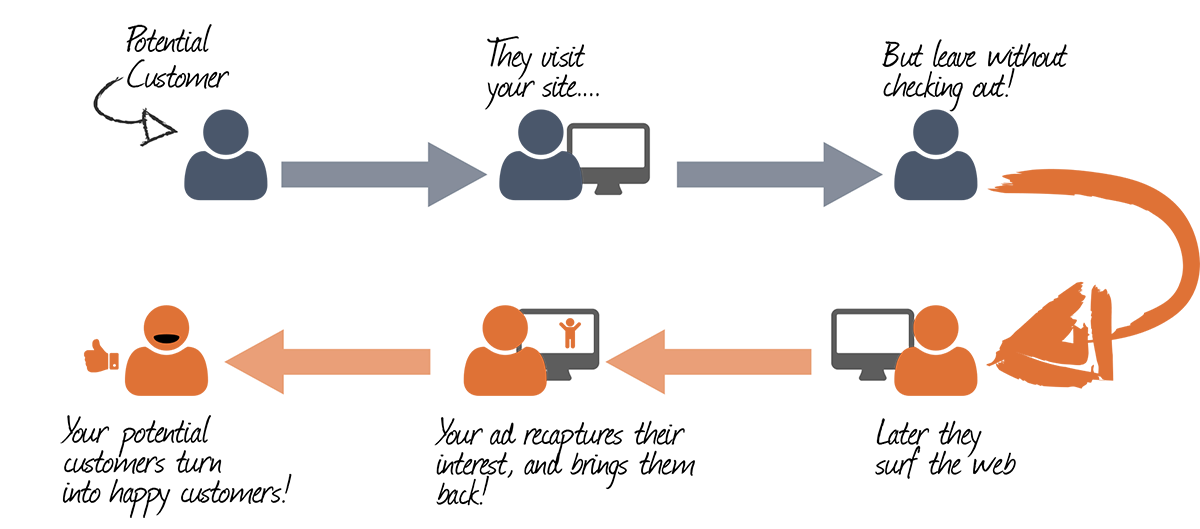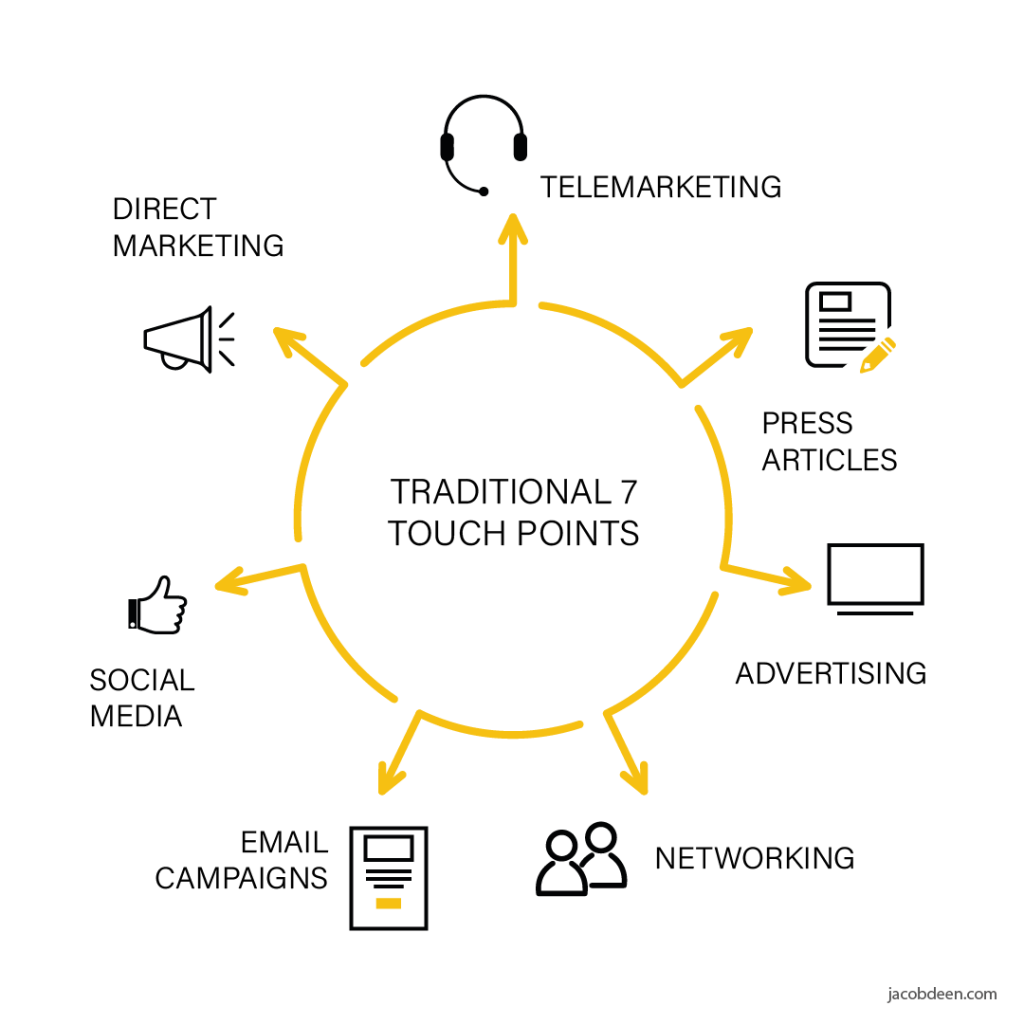Picture this: You’re moving into a new home in a month and have started online shopping for furniture. You see a coffee table from Birch & Oak that you like, add to your shopping cart, but don’t buy—yet. You have time to evaluate other options.
A few days later you notice an online ad for the exact Birch & Oak coffee table you were considering. In fact, you see an ad for this coffee table across various websites and social media platforms.
Finally, you decide to buy it.
This is retargeting in action, which (when done well) can be an effective tool for increasing conversion rates.
Consider the following:
- Retargeted customers are 3x more likely to click on your ad than those that haven’t interacted with your business before.
- 30% of users respond positively to online ads.
- Retargeted ads get a 10x higher click rate than typical display ads.
- Traffic retargeted with ads is 70% more likely to convert on a retailer’s website.
Retargeting Definition
Retargeting is when you use ads to recapture the interest of a website visitor that left without buying or responding favorably to your calls-to-action. It gives you a chance to stay top of mind and encourage them to come back and complete a purchase.

Just the other day I realized I was being retargeted: I was looking to buy Indian wear for a friend on Kilol’s website and later saw this ad on Facebook:

How Retargeting Works
Businesses add Javascript code or a pixel to website pages, typically in the footer. The browser then places a cookie on a visitor’s computer when they land on the website. This cookie stores information about the consumer’s online behavior like the products they view, web searches, and social media use. Based on this data, retargeting vendors deliver personalized ads they think will most appeal to the individual consumer.
Note: To ensure that you’re not violating any privacy laws with retargeting, you must clearly state how you collect and use visitor data. (Remember, cookies only track users, not computers.)

Is Retargeting Annoying for Internet Users?
Some people don’t mind being tracked and willingly share their personal data to see relevant ads.

Others can find frequent retargeted ads annoying. This can happen when they see a retargeted ad from visits that didn’t reflect a serious interest.
To avoid ad fatigue among visitors, apply the marketing rule of 7. This is when you use multiple marketing channels (not just ads) to stay fresh in customers’ minds. As it turns out, the more visible and relevant you are to consumers, through multiple channels, the better the conversion chances. In fact, you sell 50% more than you would otherwise!

Are Retargeting and Remarketing the Same?
While retargeting and remarketing have the same purpose, the approach is entirely different.
Retargeting uses ads to re-engage potential customers that visited your website but left without converting (for various reasons).

Remarketing uses personalized email campaigns to re-engage visitors, a tactic that can also be quite useful in reducing customer churn rate. In fact, eMarketer data states that 80% of retail professionals find email marketing as their greatest driver of customer retention.

Static vs. Dynamic Retargeting
Static retargeting creates several versions of the same ad as a part of a broader campaign. With static retargeting, you can set parameters for which ads display to visitors based on the pages they view on the site.
Dynamic retargeting, on the other hand, is more specific: it creates personalized ads for visitors based on how they’ve interacted with your site (and often incorporates machine learning to help analyze behavior and optimize the campaign).
Tip: For some prospects, retargeting just won’t work. Once you identify these “no-go” visitors, it’s best to delete them from your list and focus on prospects that will be more receptive.
Setting the Stage For Retargeting
While there are various different targeting platforms to choose from, the two most popular ones are Google AdWords and Facebook ads. (You don’t necessarily need both, but you need to know which would be more effective in reaching your prospective clients.)
Then, you have retargeting vendors like AdRoll, Retargeter and Perfect Audience that cover various platforms (including Google).
Here are a few resources to provide a more in-depth view of getting started with these tools:
Best Practices for Retargeting Success
Segment Your Audience
Different visitors have different goals and interests; meaning retargeting won’t work with a “one-size-fits-all approach.”
For someone that visited a product page, a way to retarget could be by displaying a carousel advertisement to encourage new product discovery. For the person that abandoned their shopping cart, a retargeted ad that offers a discount or free shipping could be more effective.
Also, consider segmenting visitors on the basis of how long it’s been since they were on your site. A person who visited a week ago shouldn’t see the same ad as the person who visited a month ago.
Optimize Ads
In a HubSpot survey, 63% of people surveyed said they felt most online ads don’t look professional and insult their intelligence.
To avoid this, try to incorporate the following into your advertisements:
- Eye-catching visuals: Images must complement the ad copy. A common observation is that ads with photos of people outperform those without them.
- Crisp headline: Set user expectations in as few words as possible.
- Clean copy: Without being boring, address user’s hesitation and spark curiosity.
- Clear call-to-action: Use an action-oriented catchphrase to draw readers in. Replace overused verbs with compelling ones, such as claim, reserve, activate, etc. Use urgency if it fits the context.
- Post-click landing page: Be sure you’re delivering what users expect to find!
Set Frequency Cap
Showing an ad 100 times a day is not a strategic way to pique interest. In fact, more often than not, users will develop a “banner blindness” and ignore the ad completely.
Set a frequency cap to control how many times an ad appears to the same user. While there isn’t one ideal frequency rate, the best way to find the optimal number is to run A/B tests for your campaigns. This will help to reduce campaign costs, improve ad CTR, and increase conversions.
(It’s also worth considering a “recency cap” or how much time passes between when users see the same ad.)
Rotate Ads
A ReTargeter study revealed that running the same set of ads for about five months decreases the CTR by almost 50%. One of the common culprits is the fact that the more people see the same ad, the more easily it blends in the background. It becomes invisible, no matter how compelling the CTA is.
To overcome this hurdle draft versions of the same ad with different visuals and CTAs. Another benefit of doing this is that you’ll learn what kind of messaging visitors are more inclined to respond to.
Use Burn Pixel
Retargeting the wrong audience is a waste of time and your marketing budget. To prevent this from happening try using a burn pixel: a snippet code that’s placed on a post-transaction page to remove users who complete a purchase.
The goal is to not retarget these customers with the same item they already purchased, but move them to campaigns that focus on upselling and cross-selling based on their purchase history.
Conclusion
Retargeting can boost your ROI, create brand awareness and drive conversions. But, when it comes across as pushy to users, it can actually cause prospects to turn away for good. It’s important to segment audiences, establish the right cadence, and to keep testing to stay relevant and incentivize users to return to your site.




